AMD Announces Radeon RX 6000M Series: RDNA2 Makes Its Laptop Debut
by Ryan Smith on May 31, 2021 10:45 PM EST
Headlining a busy Computex for AMD – and a bit of return to form in that regard – this evening the company is making several graphics and CPU-related product announcements. The most visible of which is on the GPU side of matters, where the company is launching their long-awaited Radeon RX 6000M series of laptop graphics adapters. Based on the same RDNA2 architecture that underpins AMD’s well-received desktop RX 6000 parts, the new mobile parts scale that down to power levels suitable for gaming laptops. All told, AMD is announcing three parts today – the Radeon RX 6800M, 6700M, and 6600M – with two of those parts shipping now.
Going back to CES 2021 at the start of the year, AMD has been touting laptop Radeon parts for the first half of 2021, and those parts are now landing right on schedule. All told today is a mix of new and old, with AMD releasing a new GPU as a mobile-first product (Navi 23), while also mobilizing the existing Navi 22 for use in laptops. Consequently, this means that there aren’t any major feature additions or hidden hardware capabilities to talk about for this launch. But that’s okay. AMD has plenty to offer just by bringing their RDNA2 GPUs to the laptop market.
When it launched on the desktop last year, the RDNA2 architecture was something of a turning point for AMD’s graphics division – a culmination of multiple generations’ worth of efforts to modernize their graphics architecture at both the execution and feature set levels. This has already paid off in spades for AMD on the desktop, but, as we’ll see over the coming weeks and months, it’s something that’s going to be an even bigger deal for AMD’s mobile graphics efforts.
To put things charitably for AMD, the company’s GPUs have been virtually absent from the laptop market for the last generation. Outside of their Apple commitment (with the interesting HBM-equipped Navi 12) and their experimental Dell collaboration (G5 15 SE) almost the entire laptop discrete graphics market was held by NVIDIA. And this was largely the case a generation before that, as well. AMD simply hasn’t had the hardware, software, and OEM relationships needed to drive a top-tier laptop graphics program, and that is finally changing, thanks in big part to RDNA2.
Power efficiency is incredibly important graphics performance, but that aspect is even more important for laptops. With desktop cards you can at least increase TDPs (to an extent) to buy more performance, but laptops are rigidly bound by the cooling capabilities of the form factor. So the only way to increase performance on a generational basis is to improve power efficiency, and that is an area where AMD has heavily invested into with RDNA2.
The net result is that AMD is in a much better position in this generation to fight for the laptop space. As we’ve already seen on the desktop, RDNA2 is performance and efficiency competitive, and that means AMD (finally) has the kind of architecture they need to make inroads into the laptop market. To be sure, even in the best-case scenario AMD isn’t going to immediately capture the majority of the laptop graphics market, but like their resurgence in laptop CPUs, laptop GPUs will be a multi-generational effort that has to start somewhere.
And the payoff for AMD isn’t just reputation, either. Laptop gaming continues to be a high growth area for the PC marketplace, and it can be very high margin as well, especially at the mid-to-high end. So for AMD’s graphics division, missing out on laptops hasn’t only cost them visibility and capital with game developers, but it’s left money on the table. This makes grabbing a sizable piece of the laptop all the more important for the company as part of their long-term product strategy.
But let’s not get too far ahead of ourselves. The first step for AMD is to launch a successful generation of laptop graphics adapters, which the company is aiming to do today with the Radeon RX 6000M series. Based on the Navi 22 and Navi 23 GPUs, AMD is taking their most power efficient graphics architecture yet and dropping it into laptops, looking to go toe-to-toe with arch-rival NVIDIA for the mid-range and high-end gaming laptop segments.
| AMD Radeon RX Mobile Series Specification Comparison | ||||||
| AMD Radeon RX 6800M | AMD Radeon RX 6700M | AMD Radeon RX 6600M | AMD Radeon RX 5600M | |||
| Stream Processors | 2560 (40 CUs) |
2304 (36 CUs) |
1792 (28 CUs) |
2304 (36 CUs) |
||
| ROPs | 64 | 64 | 64 | 64 | ||
| Game Clock | 2300MHz | <=2300MHz | <=2177MHz | 1375MHz | ||
| Boost Clock | N/A | N/A | N/A | 1560MHz | ||
| Throughput (FP32) | 11.8 TFLOPS | 10.6 TFLOPS | 7.8 TFLOPS | 6.3 TFLOPS | ||
| Memory Clock | Up to 16 Gbps GDDR6 | Up to 16 Gbps GDDR6 | Up to 16 Gbps GDDR6 | 12 Gbps GDDR6 | ||
| Memory Bus Width | 192-bit | 160-bit | 128-bit | 192-bit | ||
| VRAM | 12GB | 10GB | 8GB | 6GB | ||
| Infinity Cache | 96MB | 80MB | 32MB | N/A | ||
| TGP Range | 145W+ | 80 - 135W | 50 - 100W | 60W++ | ||
| Manufacturing Process | TSMC 7nm | TSMC 7nm | TSMC 7nm | TSMC 7nm | ||
| Transistor Count | 17.2B | 17.2B | 11.06B | 10.3B | ||
| Architecture | RDNA2 | RDNA2 | RDNA2 | RDNA (1) | ||
| GPU | Navi 22 | Navi 22 | Navi 23 | Navi 10 | ||
| Launch Date | 06/2021 | TBA | 06/2021 | 01/2020 | ||
Overall, AMD’s mobile graphics lineup is undergoing a bit of a realignment with this generation. Whereas the 5000M series was largely a mirror of the desktop parts running at lower clockspeeds and TDPs (e.g. a Navi 10-based 5600M), the 6000M series is closer to being independently aligned. Meaning that the Radeon RX 6800M, for example, is not based on the same GPU as the desktop 6800 (Navi 21), but rather the GPU used in the 6700 XT (Navi 22). All of which ends up being a similar tack to what NVIDIA has done as well for this generation of laptop parts. Though unlike NVIDIA, having explicitly-named laptop parts means that there should be much less confusion about whether a part is desktop or laptop (and its resulting performance class).
Radeon RX 6800M
Leading the charge for AMD’s new mobile lineup is the Radeon RX 6800M. As previously noted, this is based on the Navi 22 GPU, and in many respects can be thought of as a mobilized 6700 XT. The 6800M features the same 40 CUs and 64 ROPs as the desktop card; the only thing AMD has scaled down is the clockspeeds, to more mobile-friendly values. Even then, the 6800M still ships with a game clock rating that’s well over 2GHz, making it by far the highest clocked laptop GPU we’ve ever seen.
Like its desktop counterpart, the 6800M is being paired up with 12GB of GDDR6 memory. Though according to AMD, memory speeds for the 6800M (and all other 6000M) parts are “up to” speeds. In the case of our 6800M-equipped ASUS ROG laptop, it uses 16Gbps GDDR6, so it’s being kept fully fed with regards to memory bandwidth. However, this means that it’s possible other vendors may opt for slower/lower-power 14Gbps memory. As for AMD’s Infinity Cache, that isn’t being scaled back for this part at all; the full 96MB of SRAM ships enabled on the 6800M, and remains one of AMD’s key developments for improving power efficiency.
A fully-enabled Navi 22 setup does come at a cost, though, and that’s power. The 6800M has a 145W+ TGP rating, meaning that laptop implementations will start at 145W, and they can go higher from there. According to AMD we should see 6800M laptops configured for 145W to 165W or so, which would be comparable to high-end GTX 3080 laptop configurations.
With regards to performance, AMD is pitching the 6800M as the ideal solution for 1440p gaming. And, judging from what we’ve seen with its desktop counterpart, the 6700 XT, this should be a reasonably attainable goal even with laptop clockspeeds. Though don’t be surprised if you also see 1080p displays on 6800M laptops, as well, as some OEMs will be catering to esports gamers who are looking for minimal frame times/latency.
Radeon RX 6700M
Coming in below the 6800M is the Radeon RX 6700M. This is another Navi 22-based part, however it features a cut-down configuration and slightly lower TGP to match. Overall, the 6700M comes with 36 CUs enabled, marking the first time we’ve seen a cut-down version of this GPU. AMD has not dialed down the GPU clockspeeds, however, and at its full TGP the card is rated for the same 2.3GHz game clock as the 6800M. So relative to the 6800M, on paper the 6700M can offer 90% of the former’s compute/shader throughput.
Along with cutting back on the GPU itself, the 6700M also takes a step down in memory bandwidth and capacity. Here AMD is shipping the part with a 160-bit memory bus (essentially disabling a GDDR6 memory channel), which fully-populated gives the part 10GB of GDDR6 memory. Like the 6800M, it’s “up to” 16Gbps. In which case, at equal memory clocks, that gives the 6700M 83% of the 6800M’s memory bandwidth, a bit of a bigger cut than GPU throughput, but not by too much. The story is much the same for the Infinity Cache; 6700M gets 80MB of it, so it has a bit less onboard cache to play with as well.
Versus the 6800M, AMD hasn’t significantly cut back the 6700M, and this does get reflected in the TGPs. According to AMD a full-speed 6700M is 135W, only 10 Watts lower than the 6800M. However, unlike the 6800M, this is a top-end TGP, so OEMs can (and will) also design laptops with lower TGPs (and lower resulting performance). Overall, the 6700M is expected to go into laptops in the 80-135W range, so it will encompass a pretty wide range of designs. Accordingly, we won’t be too surprised if the 6700M ends up being a more common sight than the 6800M, since it can go in a lot more than supercooled high-end gaming laptops.
Finally, dialing back the performance of the 6700M also means that its target market segment is a bit lower as well. AMD is pitching this part as straddling the line for 1440p and 1080p gaming. Realistically, high TGP configurations should come fairly close to the 6800M (which is to say, fast enough for 1440p), while lower TGP configurations may end up a better fit for very fast 1080p gaming.
Radeon RX 6600M
Last, but not least among the Radeon RX 6000M product stack is the Radeon RX 6600M, which happens to be the only part being announced today that is based on a new GPU. The lightest memory of AMD’s laptop graphics adapter lineup, the 6600M is based on the Navi 23 GPU, the next step down in AMD’s GPU stack. With 11.06B transistors and a die size of 237mm2, Navi 23 is a further scaled-back Navi 2x design, similar to the step down from Navi 21 to Navi 22.
When fully enabled, Navi 23 is a 32 CU design with a 128-bit memory bus. This is still 80% the CU count of Navi 22 and 66% of its memory bus, accordingly, which is not a particularly large drop in resources. Instead, it looks like most of AMD’s transistor and die size savings for this smaller GPU are coming from the Infinity Cache, where there’s only 32MB of the SRAM available. Compared to the 96MB that shipped on Navi 22 (and the 80MB enabled on 6700M) this is a far larger step down. It removes over 3.2 billion transistors on its own (over half of AMD’s transistor savings), making Navi 23 significantly cheaper to manufacture, but it will be very interesting to see what the real-world performance repercussions are.
In any case, the 6600M will not be shipping with a fully-enabled Navi 23 configuration. Instead, AMD is shipping it with 28 CUs, and relative to the other 6000M parts, a slightly more conservative game clock of 2177MHz for a full-TGP configuration. On paper, this puts the 6600M at around 66% of the 6700M’s shader and compute throughput.
Navi 23’s 128-bit memory bus means that memory bandwidth has been dialed down proportionally as well. The laptop graphics adapter will ship with 8GB of GDDR6 running at up to 16Gbps, which is equivalent to shaving off 20% of 6700M’s bandwidth. The greater impact to be felt will be with the Infinity Cache, which as we mentioned previously is now just 32MB. The smaller cache increases the chances that memory operations will spill over into VRAM, so Navi 23 faces a bit of a double-whammy in that regard.
Otherwise, the smallest member of the 6600M stack is also the lowest-powered member. A top-end TGP configuration is 100W, and according to AMD, laptops OEMs can turn this down as far as 50 Watts. Which means that while this part can’t go into truly thin and light laptops (few of which have room for a dGPU as it is), at lower TGPs it shouldn’t require a bulky chassis, either. Following the traditional power/cost/volume curves, if AMD is successful in carving out a bigger piece of the laptop market for itself, the 6600M will almost certainly be the most common of the 6000M parts.
As for specific performance expectations, AMD is pitching the 6600M for 1080p gaming. Until we have a chance to see 6600M in action it’s difficult to say with certainty how well the part will fill this role, but 1080p seems reasonable for the hardware configuration. The real wildcard factor here is the Infinity Cache, and how well a 32MB cache ends up working. Aiming the part at 1080p gaming will certainly keep the image buffer sizes down, but not by as much as the overall cache size has been reduced.
Features, the Competition, & Availability
Alongside their raw compute capabilities, AMD’s new mobile products also support all of the new functionality AMD introduced with the 6000 series overall. This includes Smart Access Memory, AMD’s implementation of the PCIe resizable bar. This functionality is baked into the drivers and Navi 2x hardware itself, so it comes to AMD’s mobile team essentially ready-made. However whether it will be enabled on laptops still comes down to OEMs; other than AMD Advantage certified laptops, AMD can’t guarantee whether any given 6000M laptop will have SAM available.
SmartShift support is also returning for the mobile Radeon parts. The TDP shifting feature was first introduced into AMD’s hardware in 2020, when the company rolled it out in Dell’s G5 15 SE laptop, an all-AMD laptop that combined a Radeon RX 5600M with a Ryzen 4000 series APU. The Dell system was essentially a test-run for the feature – hence being the only system to ship with it in 2020 – and now that SmartShift has proven its value, it’s being made available to the rest of the OEM ecosystem. Being able to dynamically shift TDPs between the CPU and GPU should allow AMD OEMs to squeeze out a bit more performance from their laptops. And though it requires OEMs to buy both AMD CPUs and GPUs, judging from AMD’s recent success in the laptop CPU space, that task has become a whole lot easier since a couple of years ago.
Moving on, AMD’s expected competition for the Radeon RX 6000M parts is, unsurprisingly, NVIDIA’s GeForce RTX 30 series laptop adapters. AMD simply hasn’t been seriously competitive against NVIDIA in this space for a couple of generations now, so while it’s more a return to form for AMD, it’s been a long time coming.
Since everyone is playing in the same TDP-constrained space, AMD is aiming for no less than the top here. The company believes that the 6800M can compete with the RTX 3080, for example, and while we’ll have to wait for benchmarks to see how true that is, coming off of what we’ve seen with their desktop parts, AMD has some credibility here. At the same time, these are marketing slides, so they should always be taken with a grain of salt.
The company is also touting 6800M’s performance advantage over 3080 in situations where the laptops are running on batteries. This is a slightly more unusual claim (given the short battery life, how many laptop gamers do it on battery power?), and I imagine will feed back pretty heavily into whether a given system has SmartShift/Dynamic Boost support.
But even if the 6800M can’t beat the RTX 3080, AMD is still expecting it to deliver very high performance at 1440p. This is something that, judging from the desktop 6700 XT, is entirely possible.
As for the 6600M, AMD is claiming that the 1080p-targetted GPU should have no trouble delivering 60fps (or better) in major games. I suspect this won’t extend to ray tracing-enabled games (which tend to clobber everything), but otherwise this seems quite attainable for what seems like an increasingly low-end resolution in the gaming laptop market.
Wrapping things up, according to AMD both the Radeon RX 6800M and 6600M are shipping now. We already have the 6800M in-house via ASUS’s ROG Strix G15, which AMD has sampled to the press for this launch, and that laptop will be available at retail in June. The story is apparently similar for 6600M laptops, which those laptops reaching retailers now. That leaves the 6700M as the odd chip out; that’s going to be the last part AMD ships, and they haven’t said when this will be. And prices for all of these laptops is to be determined;
As for pricing, AMD isn’t working with OEMs to have a defined pricing structure in the same way that NVIDIA does, so at this juncture we don’t have planned MSRPs or such available. Like seemingly all computer hardware this year, retail prices (and availability) may end up at the whims of a crypto-crazed market.


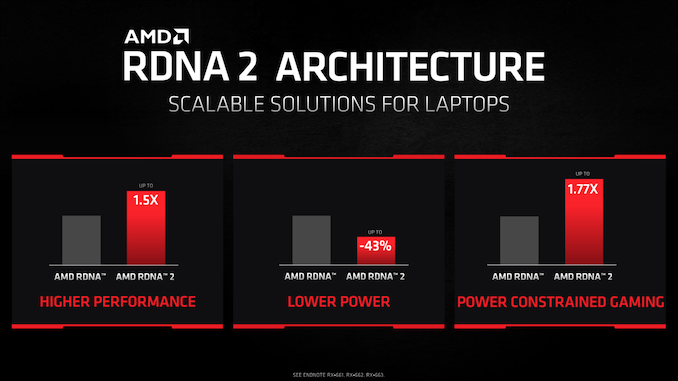
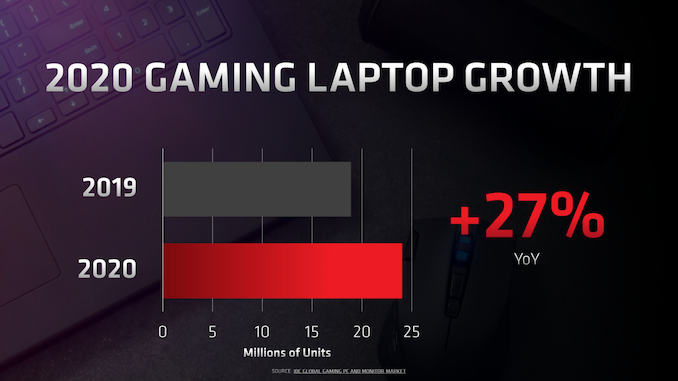
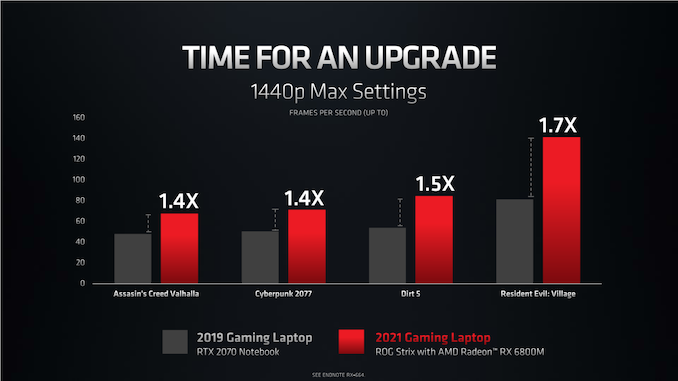
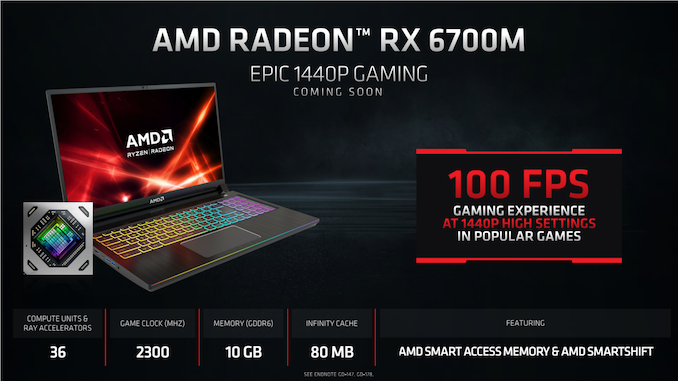

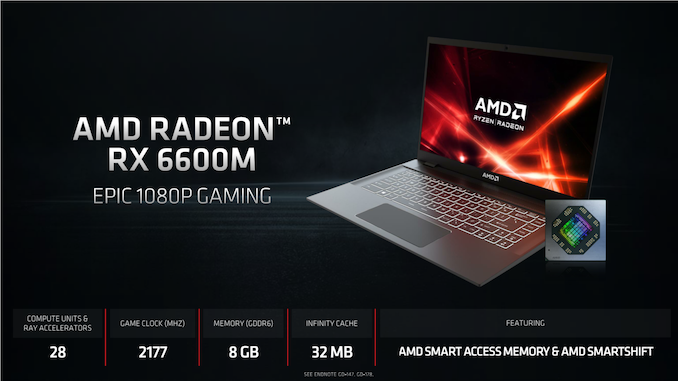
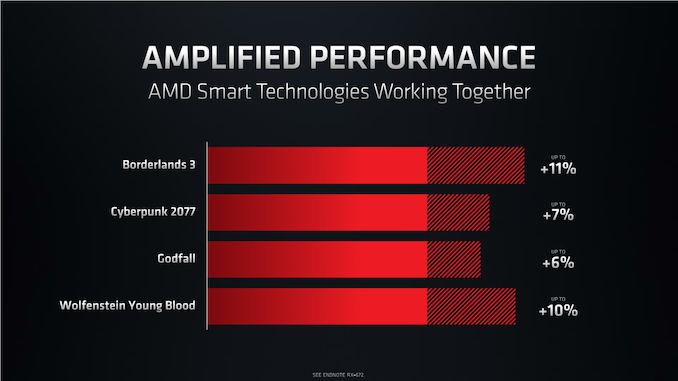

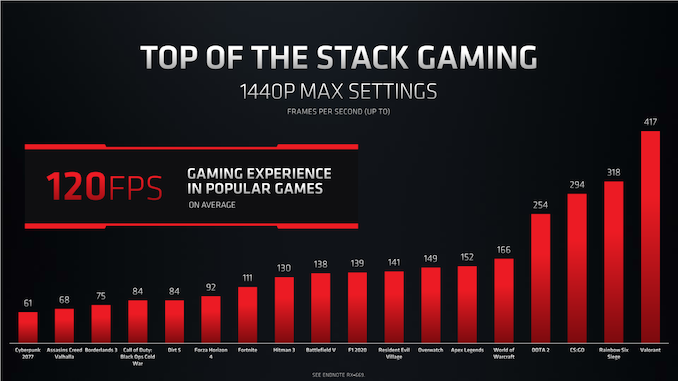
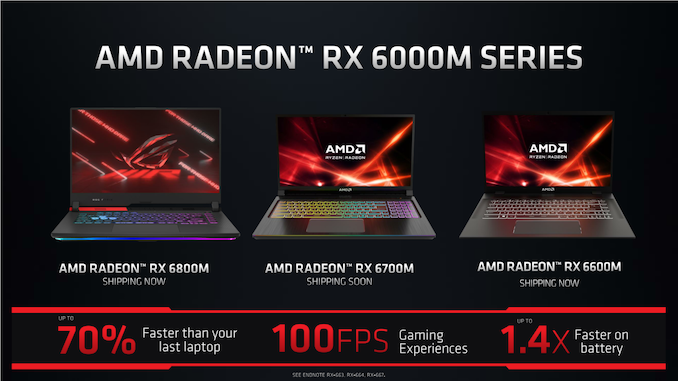














9 Comments
View All Comments
Hulk - Monday, May 31, 2021 - link
Mobile mining?IBM760XL - Monday, May 31, 2021 - link
On the subject of gaming while on batteries:I don't know how important it is, but I certainly have gamed on battery. A couple examples include the Trackmania racing series, playing on airplanes, and party games where you can pass the laptop around on battery more easily than where it's plugged in (Keep Talking and Nobody Explodes is a good example).
The 6700M and 6800M still seem far too power-hungry for these use cases, but the 6600M at 50W might be doable. In a good case, you're looking at 1.5 hours of battery life, remembering the screen + CPU et. al. also need some power. Still, I suspect lower-end options (an eventual 6500M?) would be the real sweet spot for unplugged gaming. The laptop I used the most for airborne gaming has a 20W dGPU, and a 86 WHr battery. Other parts were less efficient than today's parts (CCFL screen versus LED, for example), but even so a couple hours of mobile gaming was not too much to ask, better than any result you can hope for with a 50W dGPU today.
It probably wouldn't be a deciding factor for me today, but it's interesting to hear AMD is at least thinking about, "can you game on this while unplugged?", and I'd like to see a modern laptop where the answer is, "maybe not at max settings, but yes, for several hours!" And even if not, more power efficiency means less noise, and having heard my flatmate's helicopter-like 2080 laptop, that's definitely a good thing.
nandnandnand - Tuesday, June 1, 2021 - link
Intel made a point of AMD performing worse while on battery when they launched Tiger Lake. So that's probably why AMD is highlighting that stat.https://www.notebookcheck.net/AMD-Ryzen-4000-APUs-...
ads295 - Tuesday, June 1, 2021 - link
I guess the only serious option there is to use a good AMD APU with a high performance iGPU.ET - Tuesday, June 1, 2021 - link
I think that potentially even the 6800M and 6700M should be able to drop to 50W for gaming on battery, but I don't know what they do in practice.. I think it's unfortunate that Anandtech's review didn't test battery life for gaming and performance while gaming on battery.If the 6600M can drop to 25W on battery (and still perform reasonably well), that'd be great.
Otritus - Wednesday, June 2, 2021 - link
Where is the 5.5 FP32 TFLOPS for the 5600M coming from? At 1.375Ghz that's 6336 GFLOPS, and at 1.560Ghz that's 7188 GFLOPS.Ryan Smith - Thursday, June 3, 2021 - link
It comes from an inability to do math, apparently. Thanks!Gracie C. Wilson - Thursday, June 10, 2021 - link
Nothing can start a war quicker in a preschool classroom than different colored chairs. Some kids will refuse to sit unless they can claim their preferred color. If someone else has that color, an argument ensues. There may be tears. Or a tussle. Teachers must arbitrate.Gracie C. Wilson - Thursday, June 10, 2021 - link
Sadly, falls will come. Points will be lost. But the program isn’t over as long as the skater recovers and continues. You can be sure the performer will be working on that element to assure future success!https://en.wikipedia.org/In the world of competition, winning is everything. But in the Christian life, losing can be winning!